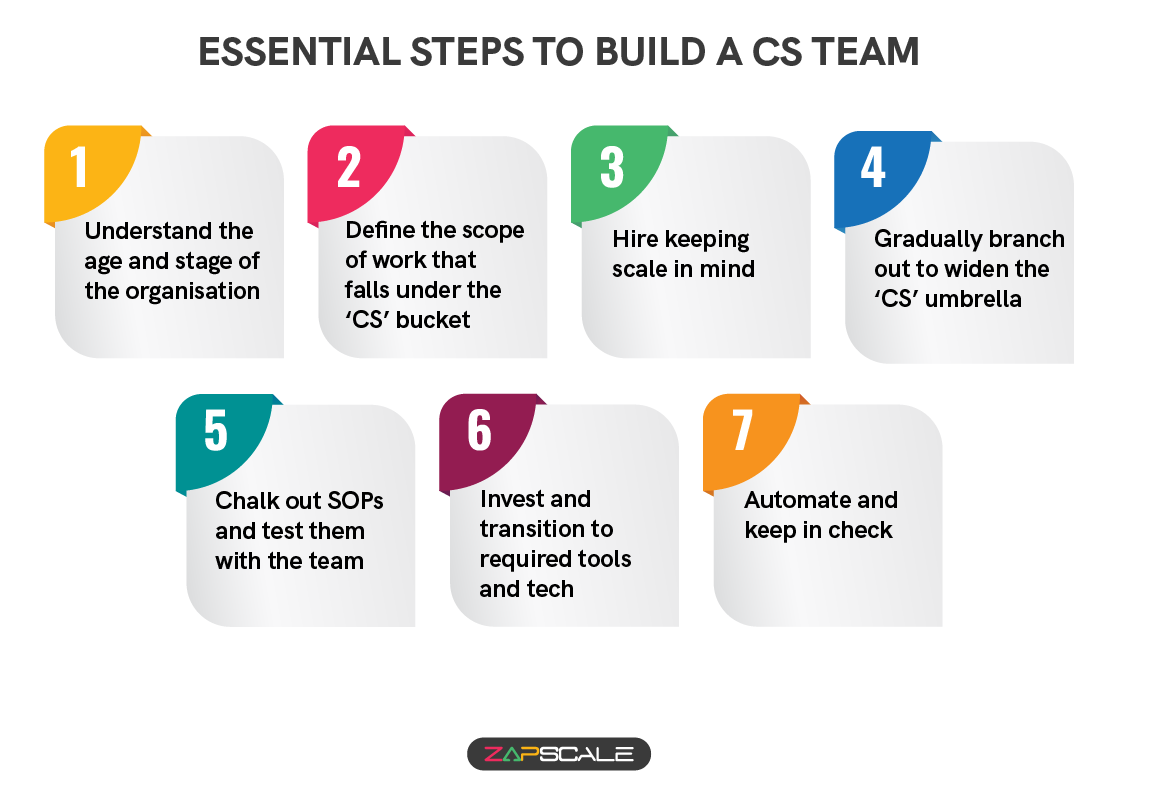CATEGORY > Customer Success Management
How To Build A Customer Success Team In A Start-Up?

What Truly Matters For Any SaaS Business & How Can Customer Success Achieve This?
I am going to take the lead from one of my favorite SaaS company founders Jason Fried and list down some of the things he mentions time and again, to build a solid SaaS business -
It’s quite simple and pretty straightforward -
- Build something good
- Keep your costs low
- Keep your growth in check
To keep the growth in check - be it through customer retention and/or added revenue, it isn’t possible without a customer success team.
I’ve said this more than once about what customer success is when it comes to being implemented for a SaaS business.
Quoting something I have shared earlier too, it is a blend of stellar customer service, expert guidance, and genuine care.
Why Does A SaaS Business Need A CS Team?
At the risk of sounding repetitive, the key activities of value realisation - consumption - happiness building, and measuring, are carried out in close association with a customer while building relationships front-ended by the customer success function.
Now, while this is extremely important, it is also COMPLETELY OKAY to not jump straight into having a CS team from day 1.
If anything, building a CS team at the right time and evaluating when to do that is as crucial.

With NRR - net revenue retention as the guiding light for everything CS, it becomes easy to understand why a SaaS business would ultimately need a CS team.
Because the 3 pillars that drive customer success is what ultimately build for branching of the business -
- Retention
- Revenue
- Relationships
Key Steps To Building A Customer Success Team From Scratch

1. Understand The Age And Stage Of The Organisation
Whether you are bootstrapped, starting, in the funding stage, or after and plan accordingly.
2. Define The Scope Of Work That Falls Under The ‘CS’ Bucket
It’s okay if CS does everything - support, technical implementation, solutions, and everything else.
Starting with generalists and then gradually moving to specialists can help in the long run.
3. Hire Keeping Scale In Mind
Once a broader framework of understanding of roles and responsibilities is achieved, you can set out to hire based on the depth of the organization and the industry, but the guiding principle should always be scale — lean teams do just a fine job and you don’t need to hire in larger numbers.
4. Gradually Branch Out To Widen The ‘CS’ Umbrella
Once you have hired the right folks, you can then start bringing the ancillaries to build the foundation of the team and demarcate between implementation consultants, onboarding specialists, and the support team.
5. Chalk Out SOPs And Test Them With The Team
Build playbooks and follow through with the right set of stakeholders through a customer’s post-sales journey.

6. Invest And Transition To Required Tools And Tech
If you can follow a process with the basic infrastructure and draw insights and iterate to improve, it’s time you bring in tech that enables this for you.
7. Automate And Keep In Check
Having tools and technology is great, but you must keep in mind to now support the team with all required resources and documentation that ensures the coming together of all of the above-mentioned steps.
After all, a great CS team is a reflection of the internal success process an organization builds for them.
Conclusion
Building a customer success team from scratch is a strategic process that requires careful consideration of the company's stage, goals, and resources.
The journey starts with understanding the unique needs of your organization, whether you're bootstrapped or in a growth phase, and defining a broad scope for your CS team's responsibilities.
As the company grows, it's important to branch out and specialize within the CS team, creating clear SOPs and testing them in real-world scenarios to ensure effectiveness.
I’ll sum this up with a gentle reminder that retaining a customer is cheaper than acquiring a new one - don’t be penny-wise pound-foolish and utilize your company’s resources effectively to build a rock-solid CS team that is revenue-oriented and relationship-focused!
ABOUT THE AUTHOR
Popular from Customer Success Management
Quality Content,
Straight To Your Inbox!
Subscribe for the latest blogs, podcasts, webinars, and events!

Write a Blog
If you have experience in CS and
a flair for writing, we’d love to
feature you.
Write to us on
hello@zapscale.com





